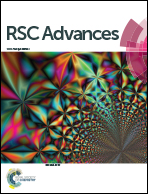Structure and mechanical properties of transparent layered nanocomposites from LAPONITE®-hydroxyethyl cellulose vacuum-assisted self-assembly†
Abstract
Transparent LAPONITE® RD/hydroxyethyl cellulose (LRD/HEC) nanocomposite films, with a full composition range of LRD (0–100 wt%), were fabricated via a facile vacuum filtration process. The influence of the LRD content on the nanostructure and mechanical properties of the nanocomposites was systematically investigated, and there exists two critical points at a LRD content of 40 wt% and 70 wt%. In the range of 0–40 wt%, the nanocomposites showed a blurry oriented structure and the mechanical performance of the nanocomposite was improved dramatically with the increase of LRD content. In the range of 40–70 wt%, the nanocomposites showed a clearly oriented lamellar nanostructure with alternating LRD nanoplatelets and HEC layers. The mechanical properties of the nanocomposite were further enhanced at a relatively low rate with the increase of the LRD content, and reached a maximum value at a LRD content of 70 wt%. At this optimum LRD content, the nanocomposite possessed a Young’s modulus of 7.09 GPa and a tensile strength of 126.66 MPa, which are 43 times and 5.5 times higher than those of pure HEC films, respectively. Whereas when the LRD content was higher than 70%, the lamellar nanostructure was converted to tactoids with deteriorated mechanical properties. It is expected that the results herein will offer deepened understanding for the fabrication of bioinspired multilayered nanocomposites.


 Please wait while we load your content...
Please wait while we load your content...